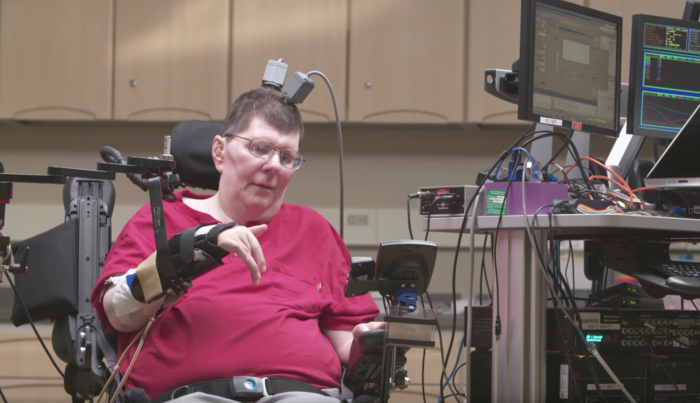ARM Wants to Put Its Chips Inside Your Brain

ARM is getting into the brain game. The U.K. chip designer is one of the biggest players in the computing industry, especially when it comes to mobile devices. But it has now announced that it’s interested in building chips meant to go in between your ears, too.
Brain implants are a hot topic right now. Earlier this year, a fully paralyzed man used a cutting-edge implant to move his arm for the first time in years. Big money is pouring in from investors in Silicon Valley who are trying to walk the fine line between solving tough research problems and building commercially viable products. Tech world A-listers, like Elon Musk and Mark Zuckerberg, are fully aboard the hype train, promising a future in which implants enhance human intelligence and make us effectively telepathic. And we even made the use of implants for reversing paralysis one of our 10 Breakthrough Technologies of 2017.
ARM’s goals appear to be somewhat more modest, at least for now. The Softbank-owned company has announced that it will partner with the University of Washington’s Center for Sensorimotor Neural Engineering to help researchers there build chips that sit inside people’s skulls. The goal: to help people who are suffering from paralysis brought about by, say, stroke or spinal cord injury to move parts of their body again.
To do that, they’ll together produce hardware that’s used for “decoding the complex signals formed within the brain, digitizing them so they can be processed and acted upon, with the end result of controlling the body’s muscle functions.” Over time, the organizations also hope to reverse the process so that the devices can process data to provide feedback directly to the brain, too.
Doing all that aboard a chip set that’s lodged inside your head raises some very particular challenges—because current implants farm those tasks out to an external computer, where constraints aren't so tight. As ARM's director of health-care technologies, Peter Ferguson, told the BBC: "The challenge is power consumption and the heat that generates." What’s required, he says, is "something ultra-small, ultra-low power."
ARM already has skin in that particular game. Its position as the go-to designer for the chips used in most of the world’s mobile devices has been cemented by the impressive energy efficiency of the chip sets it can create. In your smartphone that means the battery will last longer; in your head it means that things won’t get too hot.
Still, as others have shown, the processing of brain signals is just one computational challenge to solve. Recording neuronal activity in the first place requires a huge amount of computing power. In fact, it’s one of the focuses of the ambitious BRAIN initiative, which was launched by Barack Obama in 2013 to focus on building technologies that could interface effectively with neurons.
It’s currently unclear how far ARM’s ambitions might stretch beyond its stated aims, or whether it intends to get caught up in the techno-utopian visions of Musk and Zuckerberg. But either way, it’s setting itself a tall order. Still, it does at least appear to be tacitly aware of the magnitude of the task: it's planning on working with the team at the University of Washington for the next 10 years.
(Read more: BBC, “This Paralyzed Man Is Using a Neuroprosthetic to Move His Arm for the First Time in Years,” “$32 Billion Buyout of ARM Is a Giant Bet on the Internet of Things,” “With Neuralink, Elon Musk Promises Human-to-Human Telepathy. Don’t Believe It.”)
Deep Dive
Computing
Inside the hunt for new physics at the world’s largest particle collider
The Large Hadron Collider hasn’t seen any new particles since the discovery of the Higgs boson in 2012. Here’s what researchers are trying to do about it.
How ASML took over the chipmaking chessboard
MIT Technology Review sat down with outgoing CTO Martin van den Brink to talk about the company’s rise to dominance and the life and death of Moore’s Law.
How Wi-Fi sensing became usable tech
After a decade of obscurity, the technology is being used to track people’s movements.
Algorithms are everywhere
Three new books warn against turning into the person the algorithm thinks you are.
Stay connected
Get the latest updates from
MIT Technology Review
Discover special offers, top stories, upcoming events, and more.